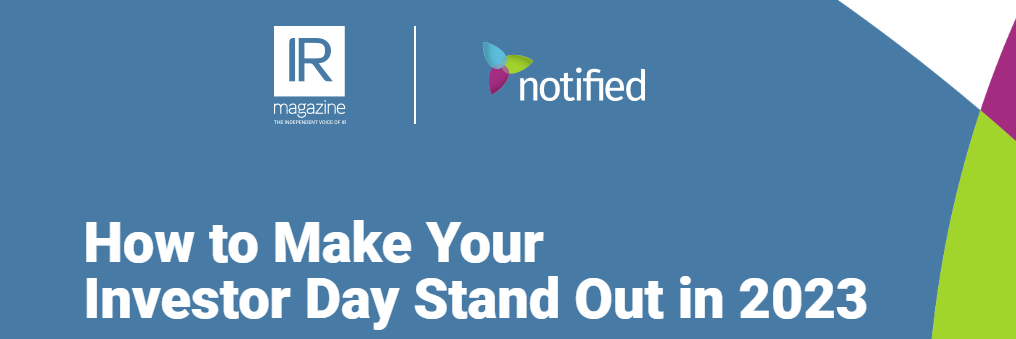
There is no better way for your company to make a splash with investors and analysts than to host an investor day. Whether the format is in-person, virtual, or hybrid, an investor day (also known as an analyst day or capital markets day) allows for a deeper dive into your company’s enterprise strategy—with participation from more of your senior leadership team—than is feasible during a non-deal roadshow or other investor conference.
Sharon Merrill President David Calusdian recently joined a panel discussion cohosted by Notified and IR Magazine to discuss best practices for making your next investor day the signature event of your IR calendar. Keeping the following takeaways in mind will give you a head start in planning your big day.

Don’t underestimate the task ahead
You might be a seasoned pro when it comes to earnings calls, but an investor day is no time for flying solo, especially if it will be your first. From vendor coordination to presentation development to day-of logistics, it is a complex undertaking that is more like an earnings call, annual meeting, and road show all rolled into one. Assemble a team of experienced professionals to guide you through the ins and outs.
It’s never too early to start planning
Six months—from your first planning meeting to the day of the event itself—is an ideal time frame, if only to nail down your preferred date and venue. New York is always a popular choice, particularly for maximizing in-person attendance, but the city’s best hotels and conference centers tend to fill up quickly, so the sooner you can commit to a date, the better.
Think “outside” of the podium
As recently as four years ago, a company might have gotten away with a staid format of presenters at a lectern and a backdrop of static slides, but the game has changed. Today, companies that fail to make use of the latest and greatest in video engagement can come off as behind the times. For example, the use of pre-recorded video segments and digital animation can be a great way to showcase what would be impractical or impossible to present live, such as a drone’s eye view of a company facility, or the drug delivery system of a new therapy. Additionally, think of different ways of contextualizing your story, such as through a “fireside chat” with key customers, partners, or other stakeholders. Introducing third-party perspectives can provide valuable context and enhance your credibility.
It’s a marathon and a sprint
A full investor day might feature a half dozen speakers, more than 100 slides and multiple video segments. However, you will test the audience’s patience if you spend more than three hours, including Q&A, presenting your story. This is where your months of planning, honing, and rehearsing the “run of show” can pay off. By refining your key messages, ensuring that all your presentations hang together as a cohesive whole, and experimenting to determine the ideal lineup and format for your team, you can pull off an event that is engaging and informative without taxing the attention span of the audience.
Don’t underestimate the value of presentation training
You’ve nailed down all the logistical details, you’ve pressure-tested your key messages, and your presentation decks have been scrutinized to perfection. Should be smooth sailing from here, right? Maybe, but don’t assume that every member of your team is ready to dazzle the audience at the drop of a hat. Your CEO might be a talented public speaker, but how about the rest of the team? The day of the event is no time to discover how anxiety-inducing a live, direct-to-camera presentation can be. Practice makes perfect, and a coach can help each presenter to play to their individual strengths while eliminating the common faults that can detract from a presentation.
An investor day can be a gift that keeps on giving
All the work that goes into such an event might seem like more hassle than it’s worth, but a successful investor day can pay dividends long after the big day. As a threshold matter, the leadership team should not underestimate the benefits of scrutinizing the company’s strategy and investment thesis, particularly if a few years have passed since the last event. What’s new? What’s changing? What aspects of your story are investors missing? The process of identifying the key questions and developing compelling responses will put management in the shoes of investors and prepare the team for every subsequent investor interaction, be it on a road show or in an earnings call Q&A. Moreover, your archived investor day materials and webcast will be an invaluable resource for new investors.
For more insights, you can view a replay of the webinar here.
Planning an Investor Day? Reach out to our Sharon Merrill team today to discuss how we can help make your investor day a great success.

